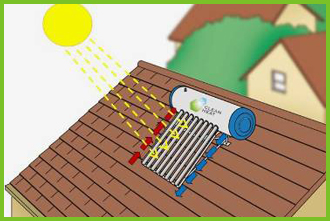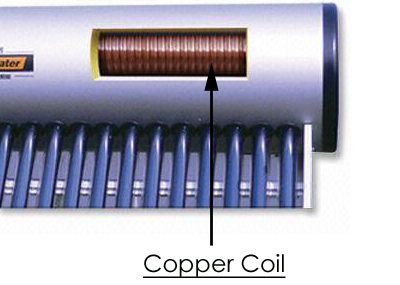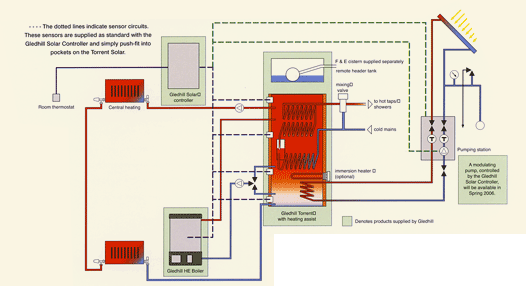How does a Solar Geyser work?
Solar Geysers, or solar water heaters, operate on a principle called "Thermo-siphoning" which, put simply, is a process of natural thermal convection. This is a process which causes warm water to rise, and cooler water to drop to the lowest point.
(Try this experiment: Take a transparent glass, heat- resistant, jug. Fill it with boiling water. Hold it to the light and watch the 'heat waves' moving down along the outer edges of the water in the jug. This is called Thermal convection. The glass is cooling the outer edges of the water down quicker than the water in the center of the jug. The warm molecules are moving upwards, and the cold molecules moving downwards to replace the molecules which moved upwards.)
In brief, the process works as follows:
Cold water enters the heat collector (vacuum collector tube) where it is warmed by the sun. As the water molecules warm up, they become less compacted and therefore less dense. In effect, these molecules become lighter and therefore rise to the highest position. This warmer water then replaces the "heavier" cold water which in turn drops to the lowest position. The process of hot water siphoning through the system is termed Thermo-siphoning.
Thus the water circulates naturally through the system.
Our geysers use evacuated glass tubes as heat collectors instead of the old-style flat plate collectors used in the past. The evacuated tubes hold many advantages over the flat plate collectors, including insulation from the ambient temperature, day-long efficiency, and better thermo-siphoning properties.

How do high Pressure Solar Geysers work?
Most Solar Geysers with evacuated tubes are low pressure units. Thus the water is gravity fed to and from the holding tank. Therefore for use in a shower or other pressure dependent use, a pressure pump is required to bring the hot water pressure to a pressure equivalent to that of municipal water.
However, it is possible to have a high pressure solar geyser. The external workings of a high pressure solar geyser are identicle to the standard low pressure system. However, the difference comes in where the high pressure system has an extra length of coiled copper tube that lies within the heated, low pressure water. This tube acts as a heat exchanger, and is connected directly to the high pressure municipal water supply. Thus, as the water moves through the coiled heat exchanger, it get heated by the surrounding water.
Solargistix no longer supply's the high pressure direct geyser system as it has been proven to be less efficient than other systems

What is a split system?
Our split system is the Retrofit unit which is coupled to an existing geyser in the roof.
A split system is where the geyser collector is separate from the heat collectors. The heat collectors are situated on top of the roof, and the geyser within the roof. Usually this means that the holding tank (geyser) is installed lower than the heat collectors due to the pitch of the roof and the space required within the roof. The disadvantages of the split sysyem are mainly in the area of cost. Besides the fact that a separate geyser and collector systems are required, this system will also require an additional circulating pump to move the hot water into the geyser as thermo-siphoning will not occur within the entire system, only within the heat collectors.

The glass tubes are fitted to a manifold which can accommodate the high pressure of the municipal water. The manifold is connected to the geyser and the water is circulated by a circulatory pump when the temperature of the water in the manifold is higher than the temperature of the water in the geyser. A digital controller is used for the monitoring and control. The control panel also has the facility to switch on the electrical back-up element should there be prolonged periods of heavily overcast weather, or high use of hot water from the tank
